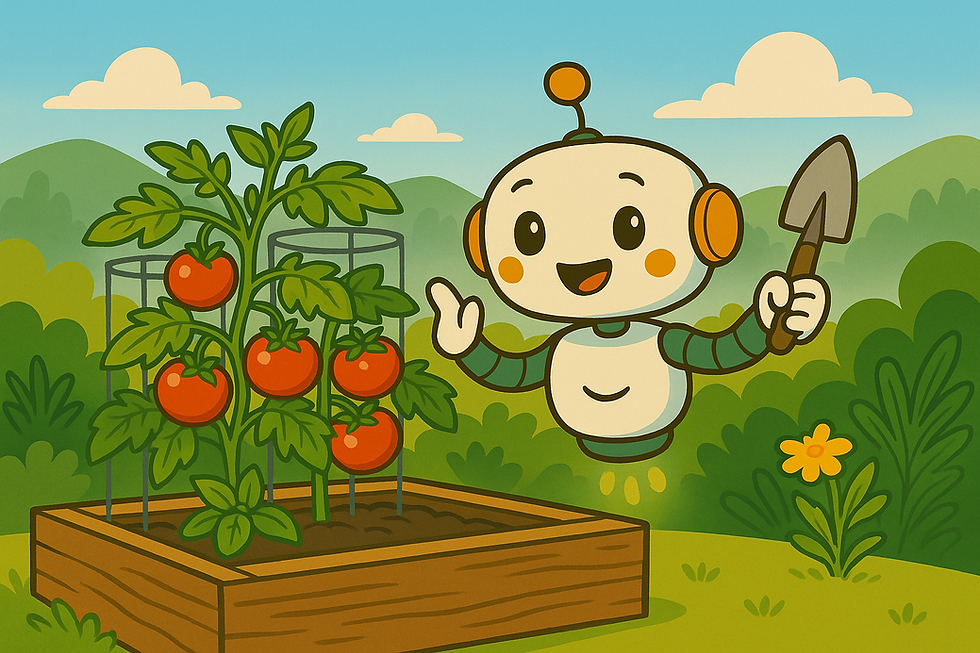Growing Guide: Tomatoes in the Bay Area (USDA Zones 9–10)
- Garden Nerd
- Aug 19
- 2 min read
Tomatoes love heat and long days—two things the Bay Area delivers unevenly. Here’s a simple, microclimate-aware plan so you know what still works now and how to set up beds and containers the right way.

Can I still plant tomatoes in August?
From seed: In most of the Bay Area, it’s a bit too late — local guidance has seed-starting Feb–Apr with transplanting May–June (~6 weeks later), so August sowings won’t size up in time.
From transplants:
Inland/hot pockets: You can tuck in sturdy early or cherry types now for a modest late harvest if nights stay warm and you give them heat and water. (Tomatoes set best with nights ≥55°F and days <90°F.)
Bay flats: Borderline; choose fast, compact or cherry varieties and a warm, protected spot.
Coast/fog belt: Usually too cool/late for new plants to pay off; if you try, pick short-season, cool-tolerant varieties and a heat-trapping site.
If you’re already holding seedlings, plant the best ones in your warmest micro-pocket and manage expectations; otherwise plan seed-starting for late winter.
Microclimate game plan
Coast & Fog Belt
Use short-season/cool-tolerant varieties; max sun, reflected heat (south wall), dark mulch.
Fruit set stalls when nights are <55°F—focus on small/early types.
Bay Flats
Warm beds, steady water, and mulch. Late cherries/early determinates can still color up if planted as transplants in a warm spot.
Inland & Hills
Best chance for late transplants. Provide deep watering and afternoon shade cloth during heat spikes to protect blossoms (fruit set drops when days >90°F).
In-ground method (quick setup)
Site: Full sun (6+ hrs), soil warmed; don’t transplant until days are reliably warm.
Soil: Mix in compost; avoid excess nitrogen (more leaves, fewer fruits).
Planting: Bury stem deep up to the top leaves; install stake/cage at planting.
Water: Deep, regular irrigation; drip or soaker preferred to keep foliage dry and conserve water.
Mulch: 2–3” organic mulch to steady soil moisture.
Container method (what actually works)
Size: We recommend 10–20+ gallons; many coastal instructions now suggest 15–20 gallons, ~24″ deep for best results—especially for vigorous or indeterminate types.
Mix: High-quality potting mix (not garden soil).
Support: Cage/stake at planting; water more frequently than in-ground.
Location: Warmest, sunniest spot; patios and south-facing walls help, especially near the coast.
Variety pointers (quick picks)
Coast/fog: short-season or cool-tolerant types highlighted by local gardeners (e.g., small/fruity cherries and early determinates).
Bay flats & inland: any reliable early/cherry for late plantings; for next season, pick what you love, but match days-to-maturity to your microclimate.
Common August issues (and easy fixes)
Flowers but no fruit → nights <55°F or hot spikes >90°F: choose early types, add warmth (coast) or shade cloth (inland) to get back into the sweet spot.
Leggy transplants → bury stem deep; remove lower leaves; support immediately.
Cracking & BER → uneven watering; switch to drip/soaker and mulch.

GrowBot did some digging… Planting late? Think small and sunny: cherry tomatoes in a 15–20 gal container parked against a south wall. It’s basically a tomato spa day, every day.
Need more info?
Want the full deep-dive — variety shortlists by microclimate, season-extension tricks (covers, walls-o-water), and a printable container sizing chart? Check the Premium Tomato Masterclass when you’re ready to plan next season.



Comments